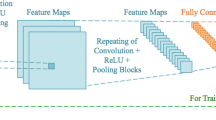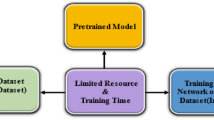Abstract
Conventional machine learning-based methods have been effective in assisting physicians in making accurate decisions and utilized in computer-aided diagnosis for more than 30 years. Recently, deep learning-based methods, and convolutional neural networks in particular, have rapidly become preferred options in medical image analysis because of their state-of-the-art performance. However, the performances of conventional and deep learning-based methods cannot be compared reliably because of their evaluations on different datasets. Hence, we developed both conventional and deep learning-based methods for lung vessel segmentation and chest radiograph registration, and subsequently compared their performances on the same datasets. The results strongly indicated the superiority of deep learning-based methods over their conventional counterparts.







Similar content being viewed by others
References
Roellinger FX, Kahveci AE, Chang JK, et al. Computer analysis of chest radiographs. Comput Graph Image Process. 1973;2(3–4):232–51.
Reiber JHC, Kooijman CJ, Slager CJ, et al. Coronary artery dimensions from cineangiograms-methodology and validation of a computer-assisted analysis procedure. IEEE Trans Med Imaging. 1984;3(3):131–41.
Spiesberger W. Mammogram inspection by computer. IEEE Trans Biomed Eng. 1979;26(4):213–9.
Giger ML, Doi K, MacMahon H. Image feature analysis and computer aided diagnosis in digital radiography. 3. Automated detection of nodules in peripheral lung fields. Med Phys. 1988;15(2):158–66.
Ginneken BV, Romeny BMTH, Viergever MA. Computer-aided diagnosis in chest radiography: a survey. IEEE Trans Med Imaging. 2001;20(12):1228–411.
Giger ML, Chan HP, Boone J. History and status of CAD and quantitative image analysis: the role of medical physics and AAPM. Med Phys. 2008;35(12):5799–820.
Doi K. Diagnostic imaging over the last 50 years: research and development in medical imaging science and technology. Phys Med Biol. 2006;51(13):5–27.
Doi K. Computer-aided diagnosis in medical imaging: historical review, current status and future potential. Comput Med Imaging Graph. 2007;31(4-5):198–21111.
Li Q. Recent progress in computer-aided diagnosis of lung nodules on thin-section CT. Comput Med Imaging Graph. 2007;31(4–5):248–57.
Li Q. Detection and diagnosis of lung nodules in thoracic CT Computer-aided detection and diagnosis in medical imaging. Chap. 2015;9:152–3.
Fukushima K. Neocognitron: a self-organizing neural network model for a mechanism of pattern recognition unaffected by shift in position. Biol Cybern. 1980;36(4):193–202.
Lo SCB, Lou SA, Lin JS, et al. Artificial convolution neural network techniques and applications for lung nodule detection. IEEE Trans Med Imaging. 1995;14(4):711–8.
Lecun Y, Bottou L, Bengio Y, et al. Gradient-based learning applied to document recognition. Proc IEEE. 1998;86(11):2278–324.
Greenspan H, van Ginneken B, Summers RM. Deep learning in medical imaging: overview and future promise of an exciting new technique. IEEE Trans Med Imaging. 2016;35(5):1153–9.
Suzuki K. Overview of deep learning in medical imaging. Radiol Phys Technol. 2017;10:257–73.
Shen D, Wu G, Suk H. Deep learning in medical image analysis. Annu Rev Biomed Eng. 2017;19:221–48.
He K, Zhang X, Ren S, et al. (2016) Deep residual learning for image recognition. IEEE conference on computer vision and pattern recognition, 770–778
Huang G, Liu Z, Maaten L V D, et al. (2017) Densely connected convolutional networks. IEEE conference on computer vision and pattern recognition, 2261–2269
Hu J, Shen L, Sun G. (2018) Squeeze-and-excitation networks. IEEE conference on computer vision and pattern recognition, 7132–7141
Litjens G, Kooi T, Bejnordi BE, et al. A survey on deep learning in medical image analysis. Med Image Anal. 2017;42:60–88.
Li Q, Sone S, Doi K. Selective enhancement filters for nodules, vessels, and airway walls in two- and three-dimensional CT scans. Med Phys. 2003;30(8):2040–51.
Gu X, Xie W, Fang Q, Li Q. The effect of pulmonary vessel suppression on computerized detection of nodules in chest CT scans. Med Phys. 2020. https://doi.org/10.1002/mp.14401.
Gu X, Wang J, Zhao J, et al. Segmentation and suppression of pulmonary vessels in low-dose chest CT scans. Med Phys. 2019;46(8):13648.
Armato SG III, McLennan G, Bidaut L, et al. Data from LIDC-IDRI. Cancer Imaging Arch. 2015. https://doi.org/10.7937/K9/TCIA.2015.LO9QL9SX.
He K, Zhang X, Ren S, et al. (2015) Delving deep into rectifiers: surpassing human-level performance on imagenet classification. IEEE International Conference on Computer Vision, 1026–1034
Kano A, Doi K, MacMahon H, et al. Digital image subtraction of temporally sequential chest images for detection of interval change. Med Phys. 1994;21(3):453–61.
Balakrishnan G, Zhao A, Sabuncu M R, et al. (2018) An Unsupervised Learning Model for Deformable Medical Image Registration. IEEE Conference on Computer Vision and Pattern Recognition, 9252–9260
Yan J, Jiang L, and Li Q. (2017) Accurate registration of temporal CT images for pulmonary nodules detection, Proceedings SPIE Medical Imaging, 10133
Zhang G, Cong L, Wang L, et al. Lung fields segmentation algorithm in chest radiography. Commun Comput Inform. 2014;437:137–44.
Fang Q, Yan J, Gu X, et al. (2020) Unsupervised learning-based deformable registration of temporal chest radiographs to detect interval change. Proc. SPIE 11313, Medical Imaging 2020: Image Processing, 113132X
Balakrishnan G, Zhao A, Sabuncu MR, et al. VoxelMorph: a learning framework for deformable medical image registration. IEEE Trans Med Imaging. 2018;38(8):1788–800.
Author information
Authors and Affiliations
Corresponding author
Additional information
Publisher's Note
Springer Nature remains neutral with regard to jurisdictional claims in published maps and institutional affiliations.
About this article
Cite this article
Guo, W., Gu, X., Fang, Q. et al. Comparison of performances of conventional and deep learning-based methods in segmentation of lung vessels and registration of chest radiographs. Radiol Phys Technol 14, 6–15 (2021). https://doi.org/10.1007/s12194-020-00584-1
Received:
Revised:
Accepted:
Published:
Issue Date:
DOI: https://doi.org/10.1007/s12194-020-00584-1




